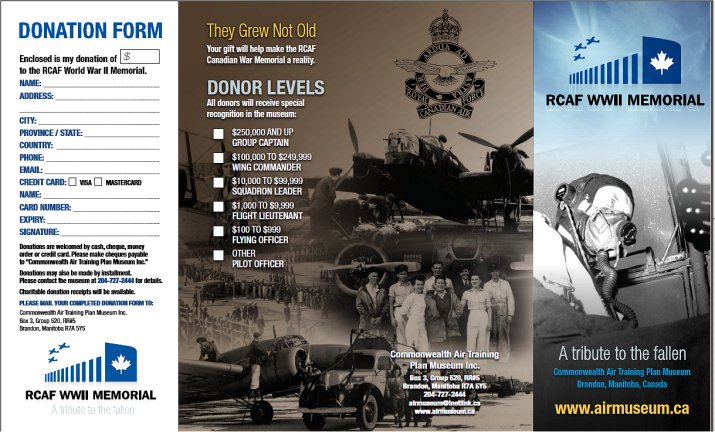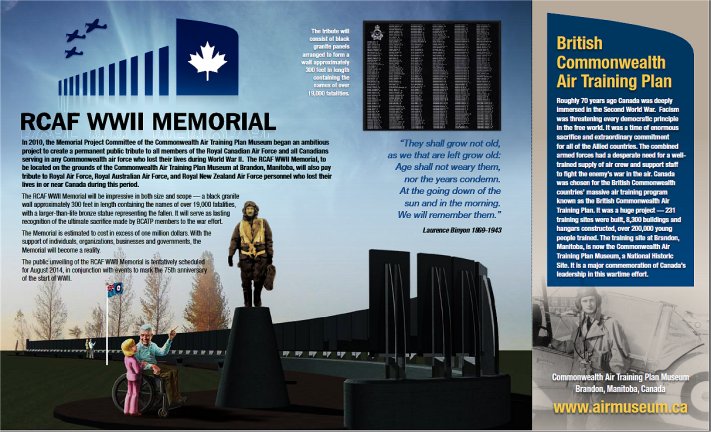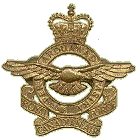Wikipedia Entries
COMMONWEALTH
AIR TRAINING PLAN MUSEUM
Brandon, MB
The Commonwealth Air Training Plan Museum is an aviation
museum located at Brandon Municipal Airport, Brandon, Manitoba. It is dedicated
to the memory of the airmen from the British Commonwealth Air Training
Plan, who trained at World War II air stations across Canada. The museum
in stage 1 of redevelopment, which will see it restored to include the
main hangar, medical building, chapel, H-hut aircrew barracks, motor pool
building, canteen and interpretive center.
The museum contains several World War II aircraft, displays
of navigation, pilot, bombardier, ground crew and transport equipment,
various artifacts and a gift shop. The Commonwealth Air Training Plan Museum
is on the Canadian Register of Historic Places.
Part of a Wikipedia Series:
BCATP BACKGROUND
BRITISH COMMONWEALTH AIR TRAINING PLAN
Wikipedia
Reference
The British Commonwealth Air Training Plan (BCATP; "The
Plan"), known in some countries as the Empire Air Training Scheme (EATS),
was a massive, joint military aircrew training program created by the United
Kingdom, Canada, Australia and New Zealand, during the Second World War.BCATP/EATS
remains as one of the single largest aviation training programs in history
and was responsible for training nearly half the pilots, navigators, bomb
aimers, air gunners, wireless operators and flight engineers who served
with the Royal Air Force (RAF), Royal Australian Air Force (RAAF), Royal
Canadian Air Force (RCAF) and Royal New Zealand Air Force (RNZAF) during
the war.
CANADA
Adapted
from the Wikipedia entry
The British Commonwealth Air Training Plan illustrated
that the Commonwealth still had some military meaning during the Second
World War and was one of Canada's major contributions to the early war
effort. The BCATP was an impressive and uniting national achievement. Canada
became, during the Second World War, one of the great air training centres
contributing more than 130,000 trained aircrew to the Allied Cause. The
federal government paid three-quarters of the total bill, an amount in
excess of two and a quarter billion dollars.
On the third anniversary of the British Commonwealth Air
Training Plan, in a message ghost written by Lester B. Pearson, serving
at the Canadian legation in Washington, US president Franklin D. Roosevelt
enthused that the BCATP had transformed Canada into the "aerodrome of democracy",
a play on his earlier description of the United States as "the Arsenal
of Democracy."
Various aircraft, transport and training artefacts may
be seen at the
Commonwealth Air Training
Plan Museum, located in Brandon, Manitoba.
As Canada was the main participant, the legacy of the
plan there included a strong postwar aviation sector and many new or improved
airports across the country, the majority of which are still in use. The
classic BCATP airport consisted of three runways, each typically 2,500
ft (760 m) in length, arranged in a triangle so that aircraft could always
land (more-or-less) into the wind – that was critically important at a
time when most light training aircraft (such as the North American Harvard)
were taildraggers, which are difficult to land in strong cross-winds.
The BCATP provided an enormous and continuing economic
boost, particularly in the Western provinces that were still recovering
from the decade long depression.The final report of the BCATP Supervisory
Board calculated that “more than 3,750 members of the RAF, RAAF, RNZAF
and Allied nationals under RAF quotas married Canadian girls,” many of
whom remained in Canada to raise families.
The Commonwealth Air Training Plan (CATP) Museum is a
non-profit, charitable organisation in Brandon, Manitoba, founded and operated
by volunteers. The museum is dedicated to the preservation of the history
of the British Commonwealth Air Training Plan and serves as a unique memorial
to those airmen who trained and served, and especially those who died,
while serving their country in the air war of 1939–1945. This is the only
museum in the world dedicated solely to this goal, located in Manitoba
where so much of the training was carried out. The collection includes
14 aircraft on display with the museum's Auster, Harvard, Cornell and Stinson
HW-75 airworthy.
The Commonwealth Air Training Plan may also be regarded
as the precursor of post-war international air training schemes in Canada,
many of them involving personnel from other NATO powers.] These include
the NATO Air Training Plan (1950–1957) that graduated 4,600 pilots and
navigators from 10 countries. Later bilateral arrangements with individual
NATO powers (1959–1983), the Military Training Assistance Plan, which has
trained aircrews from developing countries since 1964 and NATO Flying Training
in Canada (NFTC), since 1998, a partnership of the Canadian Forces, Bombardier
Aerospace Corporation and participating air forces.
THE BATTLE BRITAIN
Canadian Contribution
Ref: rcaf-arc.forces.gc.ca
The airmen who Churchill dubbed “the few” comprised 2,353
pilots and air crew from Great Britain and 574 from overseas. All flew
at least one authorized operational sortie with an eligible unit of the
Royal Air Force or Fleet Air Arm from July 10 to October 31 and were awarded
the Battle of Britain clasp to the 1939-45 Star. Five hundred and forty-four
lost their lives.
More than 100 Canadians are deemed to have participated
in the Battle of Britain, and 23 lost their lives. A Royal Canadian Air
Force squadron fought during the Battle; No. 1 (Canadian) Squadron, whose
pilots were from both a regular force unit and an auxiliary unit, became
operational on August 17, 1940. It was known as “Canadian” to distinguish
itself from the RAF’s No. 1 Squadron but in February 1941 it was designated
401 Squadron.
Three members of No. 1 (Canadian) Squadron received the
Distinguished Flying Cross for their efforts during the Battle of Britain:
the commanding officer, Squadron Leader Ernie McNab; his second-in-command,
Flight Lieutenant Gordon Roy McGregor; and Flight Officer “Dal” Russel.
Canadians also fought in the RAF’s 242 “All-Canadian”
Squadron, which was heavily, although not exclusively, Canadian. It was
led by RAF Squadron Leader Douglas Bader during the Battle of Britain.
(S/L Bader has gone down in Air Force history for losing both legs in a
flying accident in 1931; he successfully re-enrolled in the RAF at the
outbreak of hostilities and serving until 1946 – including being shot down,
taken as a prisoner of war and even escaping from captivity once.)
Many more flew with other RAF squadrons – as well as Bomber
and Coastal Commands providing support to operations to prevent the German
invasion. An untold number served as ground crew, keeping the fighters
flying.
“Ground crews who serviced No. 1 (Canadian) Squadron’s
Hurricanes, sometimes under fire and routinely under pressure, received
belated recognition in June 1942,” says Halliday, “when Flight Sergeant
John R. Burdes was awarded a British Empire Medal and Flight Sergeant Cecil
M. Gale was mentioned in dispatches.
“The citation to Gale’s award read, in part: ‘Working
under trying conditions, he has maintained the squadron aircraft in a capable
manner. Owing to the intense operational activity during the latter part
of August and September, the flight maintenance crew was called upon to
work to the limit. Flt. Sgt. Gale carried out his duties, often working
from very early morning until late into the night, with a result that sufficient
aircraft for flight use were available at all times.’”
Replacing experienced pilots throughout the Battle had
been a significant challenge, especially in the early days of the Battle.
Later in the Battle replacements became less of an issue, but the pilots
became exhausted and replacements were less experienced.
The last 10 days of August, according to the Official
History of the RCAF, “had cost Fighter Command 231 pilots or almost one-quarter
of [Fighter Command’s] initial strength, and 60 per cent of those casualties
were experienced flyers who could only be replaced by inexperienced graduates
of Operational Training Units and as time wore on less and less experienced
pilots were taking to the air. …as pilots gained practical experience they
were likely to be killed, wounded, or mentally exhausted by the strain,
or else promoted into other squadrons.”
The Battle of Britain would not have been won without
the contribution of another Canadian: Max Aitkin, Lord Beaverbrook.
Churchill appointed Lord Beaverbrook, a newspaper tycoon,
Minister of Aircraft Production in May 1940. In a series of moves and innovations
that upset the senior leadership at the Air Ministry, Beaverbrook dramatically
increased the production of fighters for the war effort. “He rode roughshod
over all the happy dilatory routines of peace,” says Stokesbury. “Factory
managers and senior air force officers alike came to hate him, but without
him, or someone equally acerbic, it is hard to see how the British would
have lasted through the summer. He provided a steadily increasing flow
of aircraft, so that in spite of loses of well over 100 per cent of strength,
the RAF still ended the battle stronger than it went into it.”
In the month before Beaverbrook’s appointment, 256 fighters
were produced. In the critical month of September, as RAF losses reached
their height, Beaverbrook’s system produced 465 fighters.
And now, with the Nazi’s plan to invade Britain in tatters,
another key Canadian contribution to the war in the air would begin to
show its effect.
“As the Battle of Britain ended, the first young pilots,
observers and gunners were emerging from the schools of the [British Commonwealth]
Air Training Plan in Canada,” says Leslie Roberts. “Soon their tide would
be in full flood.”
Canadians who served
See the list at:
www.rcaf-arc.forces.gc.ca/en/battle-britain/history.page
Draft Dodgers in Reverse
Ref: Canadian
Wings
By the summer of 1940 the supply of experienced Canadian
pilots needed for flying instructors and for miscellaneous flying duties
was nearly exhausted and the RCAF looked south of the border for a fresh
supply. As the United States was not at war American pilots had to be "smuggled"
into Canada through a clandestine recruiting organization set up by Air
Marshall W.A. (Billy) Bishop. In addition, although there was no shortage
of young Canadian aircrew recruits, American boys, attracted by the publicity
given the BCATP, began crossing the border and lined up outside the nearest
recruiting centres in such members that they caused some embarrassment
to Canadian authorities. Occasionally they were followed by worried parents
who, sometimes successfully and sometimes not, pleaded with them to forget
about foreign wars and go back to school. Eventually, President Roosevelt
gave his blessing to this mass exodus and ordered that Americans going
to Canada to join the RCAF or RAF be granted exemption by the draft board.
After Pearl Harbour 1759 American members of the RCAF transferred to the
armed forces of the United States, another 2000 transferred later on and
about 5000 completed their service with the RCAF.
Overproduction
If any criticism is to be made of the BCATP it is simply
that it was too successful. By the end of 1943 it was running like a well-oiled
machine and turning out pilots faster than they could be absorbed into
operational squadrons. In February 1944, after consulting with British
authorities,Air Minister Power decided that the scheme must be slowed down.
When the brakes were applied there were still thousands of recruits in
various stages of training and they were jolted and jarred like passengers
in a railway express that suddenly grinds to a halt. To their dismay and
discouragement those anxiously waiting to begin flying training were told
they were no longer needed as pilots. Courses just begun were canceled
and the trainees given the choice of transferring to another category of
aircrew for which there was still a demand, or joining the army or navy
or taking their discharge. Student pilots who were well advanced in their
training were allowed to continue but understood that they had little chance
of being sent overseas and might be released at any time. Only the instructors,
freed from their training duties and given priority in overseas postings
found reason to rejoice.





![]()
![]()
![]()
 .
.

